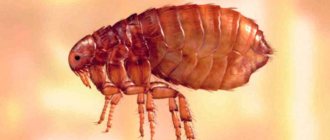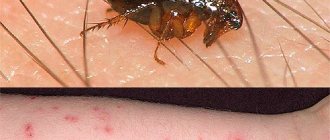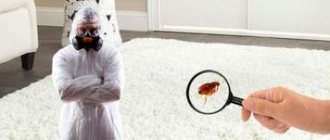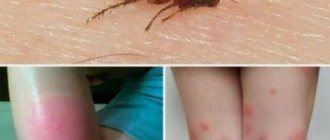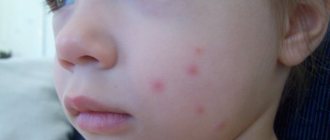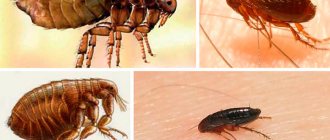Fleas are parasites that live in all countries and regions. Their food is the blood of mammals, including humans. There are mainly two species parasitizing cats and dogs: the dog flea (Ctenocephalides canis) and the cat flea (Ctenocephalides felis). Moreover, they do not need to stay on one host; fleas move from one host to another. Both species live on both cats and dogs and often attack humans.
Rat and human fleas are common in cities, but there are hundreds of other species in nature. Let's take a closer look at the dog flea. Can dog fleas bite humans, in what situations are they transmitted to humans, and what are the differences between dog and cat fleas.
What do fleas look like on dogs and how do they reproduce?
Dog fleas are small - their body length is about 2-4 mm. The chitinous cover, consisting of many bristles, allows the parasite to firmly adhere to the fur and move quickly. Fleas jump well - 3 times further than they can see.
This canine parasite is hardy, so it tolerates sudden temperature changes, high humidity, and even develops resistance to chemicals.
The flea's mouthparts are adapted to the dog's skin, but if there is a lack of food, the parasite can bite a person or other animal. If there is not enough food, the insect hibernates.
The flea has a complex reproductive system. Mating can last up to 10 hours. Almost all parasites begin copulation after drinking blood. After fertilization, the female immediately lays eggs. A flea can lay up to 10 eggs at a time.
Reproduction occurs in favorable conditions: in rags, dust, woolen products, a booth, on the floor, in clothes. The eggs are oblong in shape and resemble grains of rice.
How are cat fleas different from dog fleas?
In both cats and dogs, the cat flea (Ctenocephalides felis) is more common than the dog flea (Ctenocephalides canis). According to one study, cat fleas account for 95% of flea infestations in these animals. But the naked eye cannot distinguish one from the other.
Upon careful comparison under a microscope, you will notice that dog fleas have a steep forehead, while cat fleas have a flat forehead. The proboscis of the dog flea is longer, the stigmata of the abdominal tergites are larger, and the manubrium of the genital claw is more broadened in the male. Due to these differences, dog fleas look more massive.
Otherwise, these two species are similar to each other. The life cycle, the timing of development of eggs and larvae, the structure of the exoskeleton covered with spines and bristles - these and other features unite dog and cat fleas. Both are dangerous because they carry infectious diseases: plague, typhus, ctenocephalosis, as well as flatworms and other endoparasites.
Reasons for appearance
The flea invasion occurs in the warm season and begins in spring and ends in October. Parasites choose their refuge in private houses or on the first floor of apartment buildings.
Fleas can be caused by contact with other dogs.
The main sources are:
- dirty entrances;
- neighboring apartments;
- infected pets;
- flea colonies in the basement or attic;
- presence of rats and mice;
- garbage dumps.
Fleas lay eggs in an animal's fur, so the owner can transmit parasites to his pet if he first pets an infected dog and then a healthy one.
Why do some people get bitten and others not?
Many people ask questions: “Why don’t fleas bite everyone?” or “Why am I the only one among our family members who gets bitten?” In reality, each of us can be susceptible to possible bites, but some simply do not notice them.
According to experts, people with blood group 1 are most often susceptible to bites from bloodsuckers. It is more appetizing to insects. The blood of people of groups 3 and 4 is not of particular interest to parasites, but despite this, attacks can still occur. Fleas are also attracted to the most delicate and thin skin, elevated body temperature and the smell of human sweat.
Can they transfer to people?
Fleas cannot live on humans, so they are not transmitted to people from sick animals. However, if your pet brings this insect back from a walk, immediate action should be taken. If there are too many fleas, they may bite people in search of food.
Fleas live on bedding or carpets, in garbage. If, for example, an animal left the house for some time, and parasites remained on its blanket, then they will begin to attack people in order to satisfy their hunger.
How they bite
The oral apparatus is designed in such a way that it is convenient to suck blood . Fleas' sense of smell allows them to identify humans by the smell of carbon dioxide. Once on the body, the insect bites through the skin and begins to suck blood. The parasite's proboscis is short, so it inserts both its head and part of its body into the wound, assuming a vertical position.
The flea does not mask the bite with an anesthetic, so it causes pain to the victim. During the puncture process, the insect injects saliva, which impairs blood clotting, and along with it harmful bacteria.
Having received a portion of blood from one wound, the parasite crawls a few centimeters and makes a new one. During one feeding, the insect makes 3-5 bites.
Flea bites.
Consequences of bites
The consequences of a bite can be:
- various skin lesions, ranging from severe itching to abscesses and dermatitis;
- high fever;
- development of brucellosis;
- transfer of worms, tapeworms from the previous “owner”;
- sleep disturbance.
When scratching the bite area, boils, abscesses and growths can form.
An allergic reaction is a common consequence.
Methods for controlling dog fleas
To remove dog fleas from an apartment, disinsection of the premises is carried out simultaneously with the treatment of pets. Adult fleas live on the body of animals, and immature stages on the floor, so an incomplete set of extermination measures will only give a partial result, which is not enough.
Animal handling
Veterinary companies have developed various means of protecting animals from fleas. These include dog shampoo, flea drops, sprays, and flea collars. Folk remedies are also used, for example, vinegar baths and essential oils.
How to fight
If parasites are found, disinsection must be carried out. To treat the room you will need a soda or saline solution (you can also add insecticidal shampoo).
The algorithm of actions is as follows:
- Thoroughly vacuum the entire apartment, including upholstered furniture.
- Send for cleaning things that could harbor pests.
- Throw out the animal's bedding (it is recommended to change it more often), and treat all items belonging to the dog.
- Carry out wet cleaning with a solution.
- Close doors and windows hermetically.
- Move furniture away from the wall, treat all cracks, corners, carpets and other surfaces with insecticide.
- Leave the apartment for a few hours.
- Upon return, ventilate well.
- Do the cleaning again.
An option for flea control is a collar.
This treatment must be repeated after a week to ensure that both larvae and eggs are destroyed.
In a private house, it is necessary to treat not only the interior, but also the basement, cellar, attic and all outbuildings and the surrounding area.
Dog house treatment
The booth is disinfected after it is cleaned. To avoid “flooding”, you first need to dig drainage ditches at an angle. The entire house needs to be treated, both inside and outside.
The procedure can be carried out using an aqueous solution of formalin, creolin or Lysol. Creolin is used more often because it is easier to buy and easier to dilute with water.
Regular scheduled treatments are carried out in winter, spring and autumn. In summer, disinfection is carried out every month. The kennel is washed out unscheduled with a solution if a flea infestation has been detected, or before moving a new pet into it.
Whatever solution is used for treatment, the animal should not be allowed near the booth until it is completely dry. Otherwise, there is a risk of harming your pet's health.
Animal handling
It is possible to remove these parasites yourself at home if a severe infection has not yet occurred.
The fastest way to get rid of parasites is to use a spray. After treatment, the drug begins to act instantly, the protective effect lasts about a month. Before spraying, you need to straighten the animal's fur so that the liquid gets on the skin. Everything is treated except the head. The pet needs to be occupied with playing for a while so that the drug has time to dry.
Drops are considered a more effective remedy, but they begin to act only on the 2nd day. During this period, the animal should not be bathed so as not to wash off the medicine. The drug is applied directly to the skin from the back of the head to the withers.
A special flea collar is the safest remedy. A plastic headband with insect repellent is more suitable for prevention. You need to wear it constantly, it begins to act gradually. The duration of the collar is indicated on the packaging.
Treatment of bites
If you or your family members have had to experience flea bites, you can get rid of the painful sensations in the following way. Rinse the swollen area with water, after which it must be lubricated from time to time with a solution of antiseptic soap. You need to apply a piece of ice to the wound if an insect has just bitten you. It is very important to try not to scratch the damaged area to avoid infection.
There are products that can be used to smear flea bites after some time. Sulfur ointment, a solution of baking soda or ethyl alcohol perfectly relieves itching. You can also use vodka, brilliant green or iodine for this. Such remedies can prevent infection of the wound.
There are also traditional ways to get rid of itching. You can get rid of unpleasant sensations with the help of lotions made from a decoction of dandelion, calendula or plantain. Tea tree oil, aloe and lemon juice relieve inflammation well. You can also purchase pharmaceutical ointments, gels or creams based on hydrocortisone for these purposes.
In order not to share your living space with parasites, you need to keep your house clean. Knowing the theoretical part about how to get them out by treating the apartment and what to apply in case of a bite, you are unlikely to encounter such a problem.
Prevention measures
What to do if insects appear in the house? Do cat fleas bite humans? We found out that yes, which means that animals should be checked for parasites. We must not forget about household items. Jumping insects are able to hide in clothes, carpets, fleecy fabrics, plush toys, etc. All clothing must be washed and steamed. The room is treated with the latest generation insecticides, for example, “Raid” or “Combat”. Subsequently, it is important to carry out regular wet cleaning, vacuum upholstered furniture, and shake out rugs.
It is better to entrust the disinfection of the premises to qualified specialists. We are ready to help solve this problem if you contact us by phone or send a request by email. After sanitization of the premises, long-term ventilation is carried out. It is good if two weeks after the main treatment it is possible to carry out repeated disinfection.
People usually pay attention to flooring and furniture located in the lower part of the room. But the trouble is that fleas can jump high, hiding in curtains, wall hangings and other interior items.
If fleas bite your legs, what should you do? On the street you can protect yourself from parasites using repellents. It is enough to treat your clothes with flea spray, and reliable protection is guaranteed. It is recommended to wear closed clothing when outdoors that fits tightly around the wrists and ankles, preventing the penetration of insects. Repellents can also help at home. “For me, this is a reliable way to protect myself from insects,” says one of the owners of a large family of cats. “I monitor the health of my charges, but when the conversation turns to parasites, it’s better to be safe.”
Source
Danger to humans
When understanding the question of whether cat and dog fleas are dangerous for humans, it should be noted that the parasites themselves do not pose a threat to the victim. But if the insect has been in contact with an unhealthy animal and acts as a carrier of the disease, then when bitten, the infection can penetrate into the wound.
Therefore, concluding, doctors say that fleas living on a cat can be dangerous to humans, transmitting to them through the blood:
- Pulicosis.
- Dermatitis.
- Hepatitis.
- Typhus.
- Brucellosis.
- Salmonellosis.
- Encephalitis.
- Helminthiasis.
- Dipilidosis.
- Fever.
- Erythema.
In the Middle Ages, cat fleas caused a plague epidemic, which was dangerous for humans.
Nowadays, fleas rarely cause serious problems when they jump from cats to people. More often, patients suffer from helminthiasis; sometimes, due to intolerance, an individual severe allergic reaction occurs.


